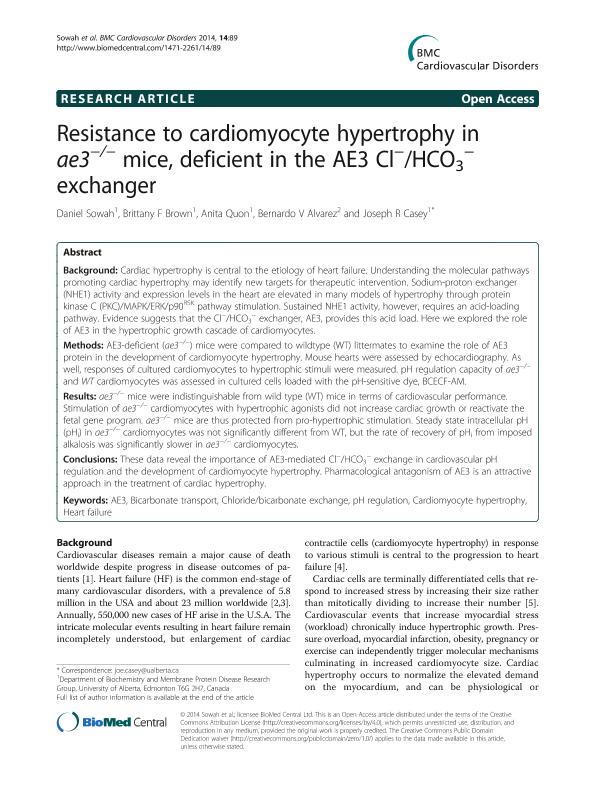Mostrar el registro sencillo del ítem
dc.contributor.author
Sowah, Daniel
dc.contributor.author
Brown, Brittany F.
dc.contributor.author
Quon, Anita
dc.contributor.author
Alvarez, Bernardo

dc.contributor.author
Casey, Joseph R.
dc.date.available
2017-01-25T20:21:38Z
dc.date.issued
2014-07
dc.identifier.citation
Sowah, Daniel; Brown, Brittany F.; Quon, Anita; Alvarez, Bernardo; Casey, Joseph R.; Resistance to cardiomyocyte hypertrophy in ae3−/− mice, deficient in the AE3 Cl− /HCO3 − exchanger; Biomed Central; Bmc Cardiovascular Disorders; 14; 89; 7-2014; 1-16
dc.identifier.issn
1471-2261
dc.identifier.uri
http://hdl.handle.net/11336/11941
dc.description.abstract
Background: Cardiac hypertrophy is central to the etiology of heart failure. Understanding the molecular pathways promoting cardiac hypertrophy may identify new targets for therapeutic intervention. Sodium-proton exchanger (NHE1) activity and expression levels in the heart are elevated in many models of hypertrophy through protein kinase C (PKC)/MAPK/ERK/p90RSK pathway stimulation. Sustained NHE1 activity, however, requires an acid-loading pathway. Evidence suggests that the Cl− /HCO3 − exchanger, AE3, provides this acid load. Here we explored the role of AE3 in the hypertrophic growth cascade of cardiomyocytes.
Methods: AE3-deficient (ae3−/− ) mice were compared to wildtype (WT) littermates to examine the role of AE3 protein in the development of cardiomyocyte hypertrophy. Mouse hearts were assessed by echocardiography. As well, responses of cultured cardiomyocytes to hypertrophic stimuli were measured. pH regulation capacity of ae3−/− and WT cardiomyocytes was assessed in cultured cells loaded with the pH-sensitive dye, BCECF-AM.
Results: ae3−/− mice were indistinguishable from wild type (WT) mice in terms of cardiovascular performance. Stimulation of ae3−/− cardiomyocytes with hypertrophic agonists did not increase cardiac growth or reactivate the fetal gene program. ae3−/− mice are thus protected from pro-hypertrophic stimulation. Steady state intracellular pH (pHi ) in ae3−/− cardiomyocytes was not significantly different from WT, but the rate of recovery of pHi from imposed alkalosis was significantly slower in ae3−/− cardiomyocytes.
Conclusions: These data reveal the importance of AE3-mediated Cl− /HCO3 − exchange in cardiovascular pH regulation and the development of cardiomyocyte hypertrophy. Pharmacological antagonism of AE3 is an attractive approach in the treatment of cardiac hypertrophy.
dc.format
application/pdf
dc.language.iso
eng
dc.publisher
Biomed Central

dc.rights
info:eu-repo/semantics/openAccess
dc.rights.uri
https://creativecommons.org/licenses/by/2.5/ar/
dc.subject
Ae3
dc.subject
Bicarbonate Transport
dc.subject
Chloride/Bicarbonate Exchange
dc.subject
Ph Regulation
dc.subject
Cardiomyocyte Hypertrophy
dc.subject
Heart Failure
dc.subject.classification
Fisiología

dc.subject.classification
Medicina Básica

dc.subject.classification
CIENCIAS MÉDICAS Y DE LA SALUD

dc.title
Resistance to cardiomyocyte hypertrophy in ae3−/− mice, deficient in the AE3 Cl− /HCO3 − exchanger
dc.type
info:eu-repo/semantics/article
dc.type
info:ar-repo/semantics/artículo
dc.type
info:eu-repo/semantics/publishedVersion
dc.date.updated
2017-01-25T13:57:47Z
dc.journal.volume
14
dc.journal.number
89
dc.journal.pagination
1-16
dc.journal.pais
Reino Unido

dc.journal.ciudad
Londres
dc.description.fil
Fil: Sowah, Daniel. University Of Alberta. Faculty Of Medicine And Oral Health Sciences; Canadá
dc.description.fil
Fil: Brown, Brittany F.. University Of Alberta. Faculty Of Medicine And Oral Health Sciences; Canadá
dc.description.fil
Fil: Quon, Anita. University Of Alberta. Faculty Of Medicine And Oral Health Sciences; Canadá
dc.description.fil
Fil: Alvarez, Bernardo. Consejo Nacional de Investigaciones Cientificas y Tecnicas. Centro Cientifico Tecnológico la Plata. Centro de Investigaciones Cardiovasculares "dr. Horacio Eugenio Cingolani"; Argentina. Universidad Nacional de la Plata. Facultad de Ciencias Médicas; Argentina
dc.description.fil
Fil: Casey, Joseph R.. University Of Alberta. Faculty Of Medicine And Oral Health Sciences; Canadá
dc.journal.title
Bmc Cardiovascular Disorders

dc.relation.alternativeid
info:eu-repo/semantics/altIdentifier/url/http://dx.doi.org/10.1186/1471-2261-14-89
dc.relation.alternativeid
info:eu-repo/semantics/altIdentifier/url/http://bmccardiovascdisord.biomedcentral.com/articles/10.1186/1471-2261-14-89
dc.relation.alternativeid
info:eu-repo/semantics/altIdentifier/url/https://www.ncbi.nlm.nih.gov/pmc/articles/PMC4120010/
Archivos asociados
